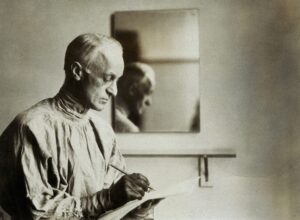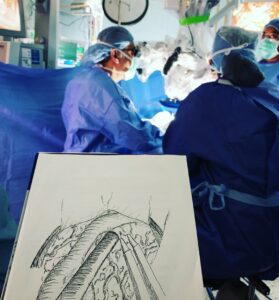In the history of neurosurgery, anatomical sketches by neurosurgeons have played an important role in the development of surgical techniques. As the father of this specialty, Harvey Cushing pioneered the field, and his operative drawings, as well as detailed descriptions of his findings and approaches, represent an important element of this legacy.[1] His drawings would often include several different views and planes of the same pathology, rendering an appreciation for complex three-dimensional anatomy for the reader that predated current imaging technology. His work and art took inspiration from the anatomical studies of Andreas Vesalius, a 16th-century anatomist, physician, and author of De Humani Corporis Fabrica Libri Septem.[2]
This classic photograph of Cushing in Figure 1, familiar to many modern neurosurgeons, shows him completing an operative sketch, still donned in surgical gown and gloves.[1,2] While he later partnered with a medical illustrator, Mildred Codding, to formally capture his technique, the accurate depiction of cases first required his own sketches to be incorporated into her illustrations. The variety of his medical sketches spans the same breadth of neurosurgical diseases he tackled and features surgery for meningiomas,[1] pediatric brain tumors,[4] spinal cord tumors,[5] dorsal rhizotomy,[6] cortical stimulation,[7] epilepsy,[8] peripheral nerves,[9] and much more.

Benefits of Sketching and Honing this Skill
A recent survey of 100 surgeons across specialties noted that technical drawing allows surgeons to visualize and understand surgical concepts, including technical schematics and operative findings, but also plays a role in communication with patients, effectively sharing information about anatomy and the possible intervention.[10] In addition, several other benefits have been delineated in the literature across disciplines:
- A body of literature on cognition supports the notion that drawing enhances memory encoding and formation.[11-14]
- fMRI data in 45 participants learning to draw, both art and non-art students, found that as improvements in learning tasks were observed, diffuse functional changes were discovered, including prefrontal cortex areas and cerebellum.[15]
- EEG data assessed during drawing among artists versus non-artists found that artists had electrographic changes associated with an increase in cognitive functioning.[16]
- Technical drawing exercises among medical students improved spatial visualization and understanding of anatomy.[17]
- A recent systematic review on surgical residents across specialties and art instruction found 7 articles that supported the inclusion of courses in either drawing or sculpting into the surgical curriculum.[18]

Many resources provide drawing instruction! A vast array from books to YouTube tutorials or in-person courses could guide or complement any artistic training. Whether you choose to enroll in a class or dabble on your own, the first step is the willingness to give it a try. Next, select your medium: pen, graphite, charcoal, paint, etc. Decide what you will draw and why you are drawing it: is this a sketch to help better understand anatomy or a drawing to remember intraoperative findings? Then, once you get started, continue to hone your skills, without being too harsh a critic.
References:
- Moore MR, Rossitch E Jr, Black PM. The development of neurosurgical techniques: the postoperative notes and sketches of Dr. Harvey Cushing. Acta Neurochir (Wien). 1989;101(3-4):93-9. doi: 10.1007/BF01410521. PMID: 2694798.
- Mifflin J. Line art [Internet]. Line Art | Harvard Medicine magazine. [cited 2022Mar10]. Available from: https://hms.harvard.edu/magazine/art-medicine/line-art.
- Harvey Cushing: Surgeon, author, soldier, historian [Internet]. Hektoen International. 2020 [cited 2022Mar10]. Available from: https://hekint.org/2020/08/17/harvey-cushing-surgeon-author-soldier-historian-1869-1939/.
- Sathi S, Rossitch E Jr, Moore MR, Black PM. Harvey Cushing’s postoperative sketches of pediatric brain tumors. Childs Nerv Syst. 1991 Feb;7(1):56-8. doi: 10.1007/BF00263836. PMID: 2054811.
- Cohen-Gadol AA, Spencer DD, Krauss WE. The development of techniques for resection of spinal cord tumors by Harvey W. Cushing. J Neurosurg Spine. 2005 Jan;2(1):92-7. doi: 10.3171/spi.2005.2.1.0092. PMID: 15658135.
- Dasenbrock HH, Pendleton C, McGirt MJ, Sciubba DM, Gokaslan ZL, Quiñones-Hinojosa A, Bydon A. “Fulfilling the chief of his duties as a physician”: Harvey Cushing, selective dorsal rhizotomy and elective spine surgery for quality of life. J Neurosurg Spine. 2011 Mar;14(3):421-7. doi: 10.3171/2010.10.SPINE10152. Epub 2011 Jan 21. PMID: 21250816; PMCID: PMC4612574.
- Leblanc R. Cushing, Penfield, and cortical stimulation. J Neurosurg. 2018 Jan 26;130(1):76-83. doi: 10.3171/2017.7.JNS171256. PMID: 29372875.
- Moore MR, Rossitch E Jr, Shillito J Jr. Cushing and epilepsy surgery: two successfully treated cases with long-term follow-up. Surg Neurol. 1989 Sep;32(3):241-5. doi: 10.1016/0090-3019(89)90187-0. PMID: 2672398.
- Tubbs RS, Patel N, Nahed BV, Cohen-Gadol AA, Spinner RJ. Reflections on the contributions of Harvey Cushing to the surgery of peripheral nerves. J Neurosurg. 2011 May;114(5):1442-8. doi: 10.3171/2010.11.JNS10804. Epub 2011 Jan 7. PMID: 21214330.
- Kearns C. Is drawing a valuable skill in surgical practice? 100 surgeons weigh in. J Vis Commun Med. 2019 Jan;42(1):4-14. doi: 10.1080/17453054.2018.1558996. Epub 2019 Feb 18. PMID: 30773071.
- Tran SHN, Beech I, Fernandes MA. Drawing compared to writing in a diary enhances recall of autobiographical memories. Neuropsychol Dev Cogn B Aging Neuropsychol Cogn. 2022 Mar 6:1-17. doi: 10.1080/13825585.2022.2047594. Epub ahead of print. PMID: 35249467.
- Meade ME, Ahmad M, Fernandes MA. Drawing pictures at encoding enhances memory in healthy older adults and in individuals with probable dementia. Neuropsychol Dev Cogn B Aging Neuropsychol Cogn. 2020 Nov;27(6):880-901. doi: 10.1080/13825585.2019.1700899. Epub 2019 Dec 13. PMID: 31833456.
- Meade ME, Wammes JD, Fernandes MA. Drawing as an Encoding Tool: Memorial Benefits in Younger and Older Adults. Exp Aging Res. 2018 Oct-Dec;44(5):369-396. doi: 10.1080/0361073X.2018.1521432. Epub 2018 Oct 9. PMID: 30300080.
- Roberts BRT, Wammes JD. Drawing and memory: Using visual production to alleviate concreteness effects. Psychon Bull Rev. 2021 Feb;28(1):259-267. doi: 10.3758/s13423-020-01804-w. Epub 2020 Sep 16. PMID: 32939630.
- Katz JS, Forloines MR, Strassberg LR, Bondy B. Observational drawing in the brain: A longitudinal exploratory fMRI study. Neuropsychologia. 2021 Sep 17;160:107960. doi: 10.1016/j.neuropsychologia.2021.107960. Epub 2021 Jul 15. PMID: 34274380.
- Kottlow M, Praeg E, Luethy C, Jancke L. Artists’ advance: decreased upper alpha power while drawing in artists compared with non-artists. Brain Topogr. 2011 Jan;23(4):392-402. doi: 10.1007/s10548-010-0163-9. Epub 2010 Oct 14. PMID: 20945085.
- Na Y, Clary DW, Rose-Reneau ZB, Segars L, Hanson A, Brauer P, Wright BW, Keim SA. Spatial Visualization of Human Anatomy through Art Using Technical Drawing Exercises. Anat Sci Educ. 2021 Apr 2. doi: 10.1002/ase.2080. Epub ahead of print. PMID: 33797858.
- Card EB, Mauch JT, Lin IC. Learner Drawing and Sculpting in Surgical Education: A Systematic Review. J Surg Res. 2021 Nov;267:577-585. doi: 10.1016/j.jss.2021.05.036. Epub 2021 Jul 12. PMID: 34265601.








